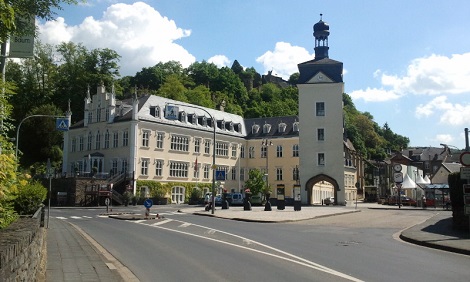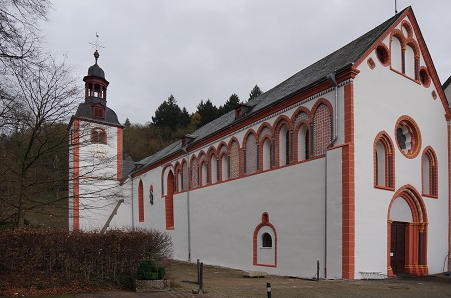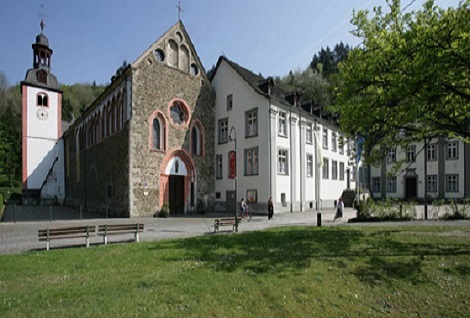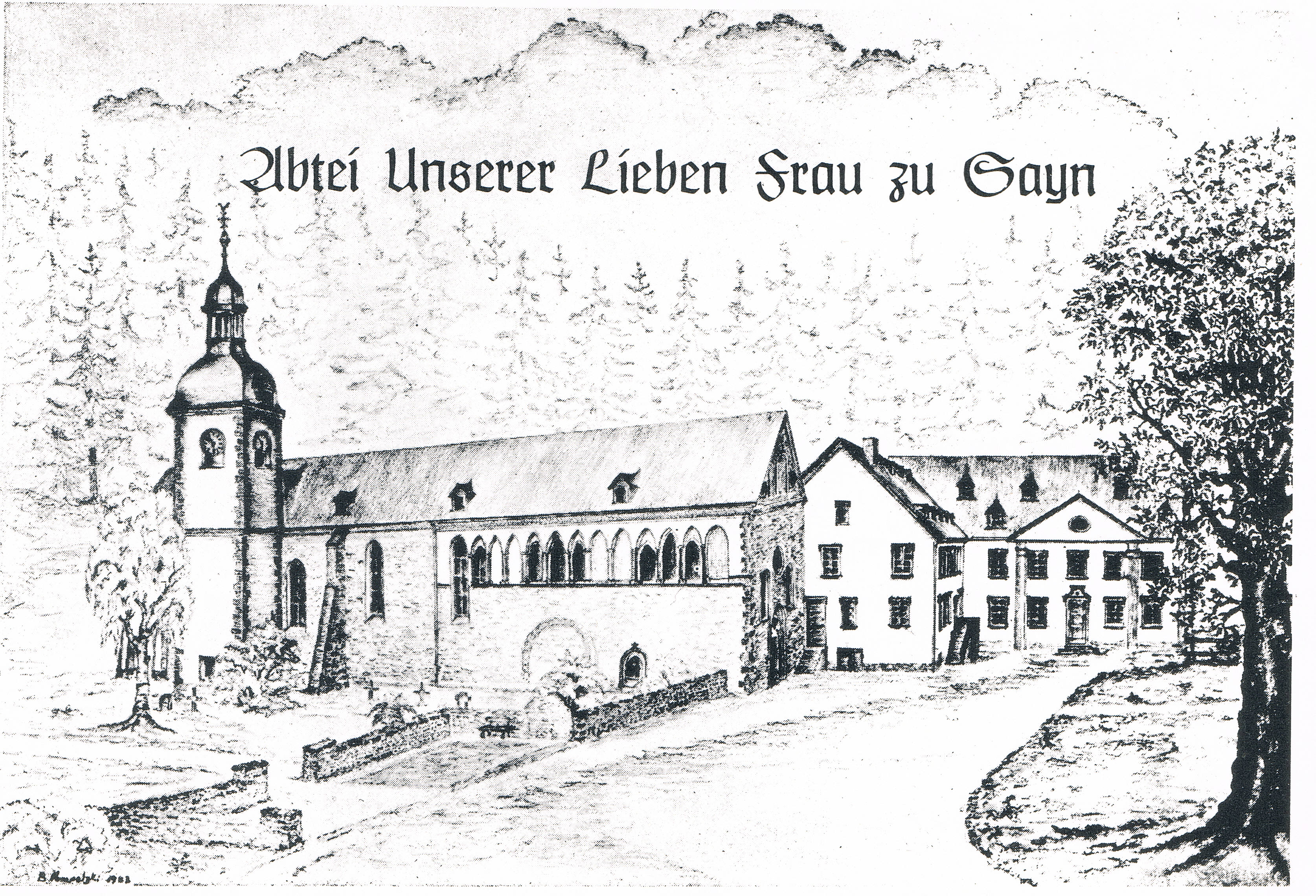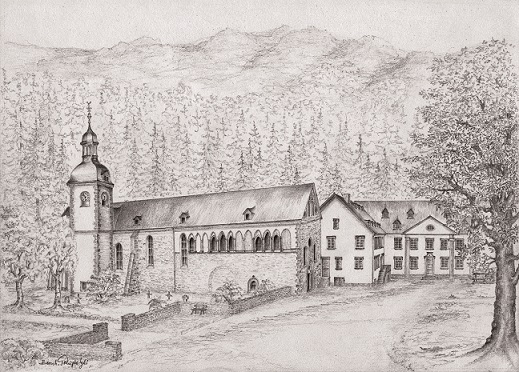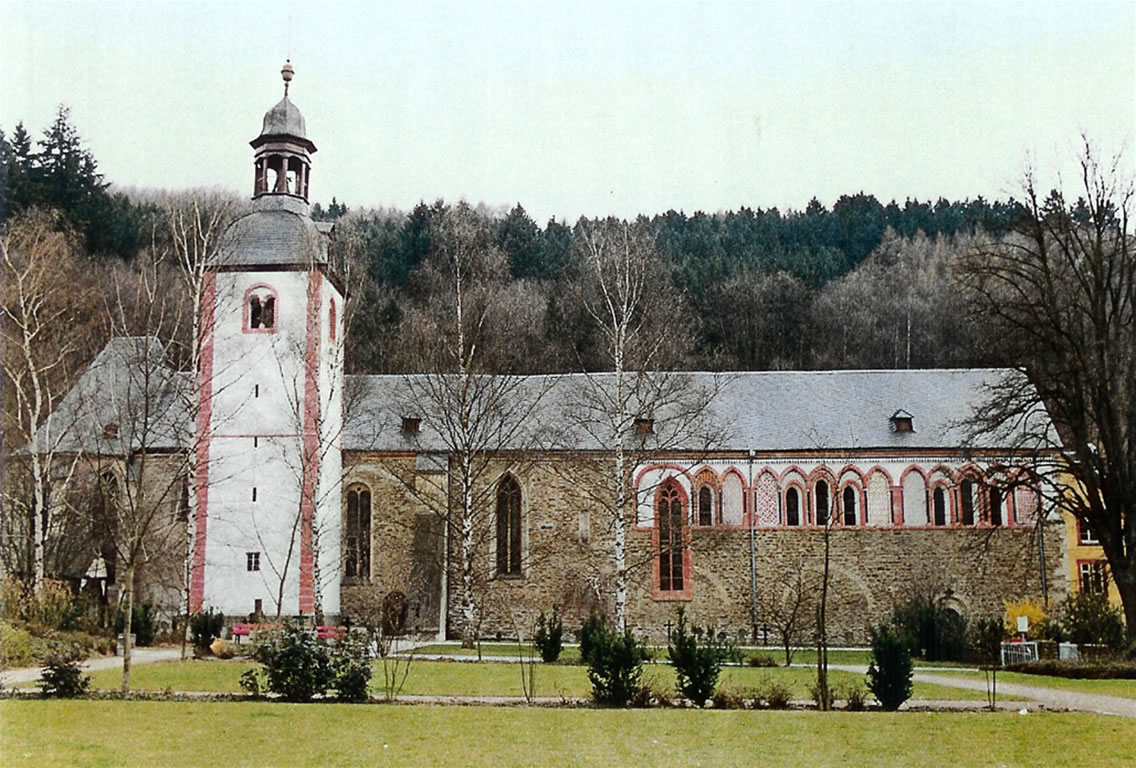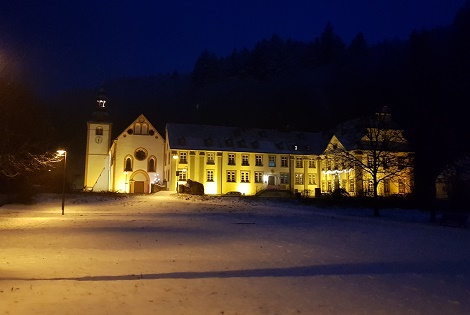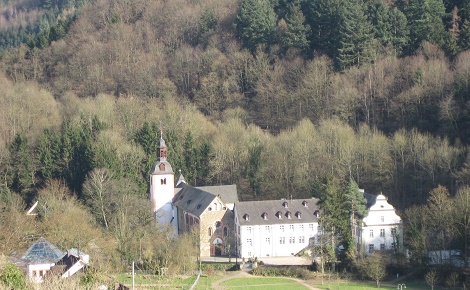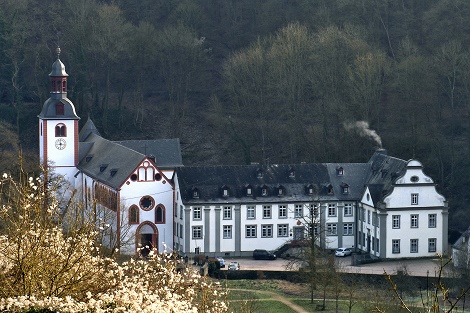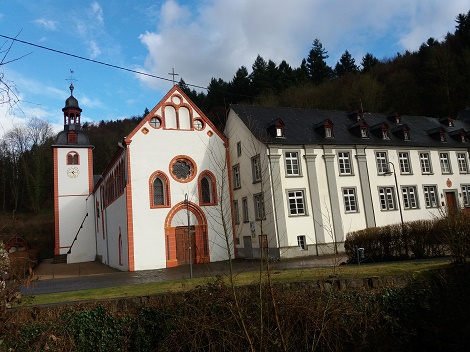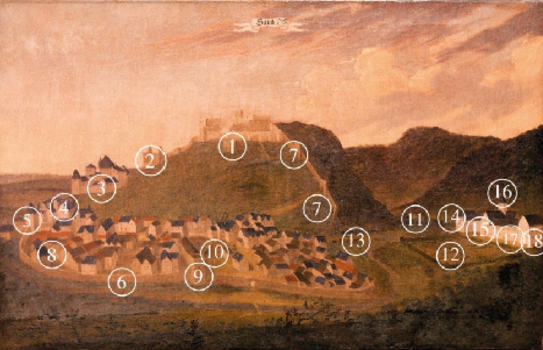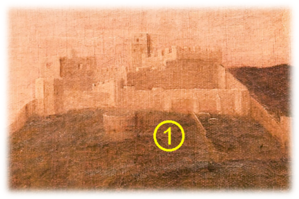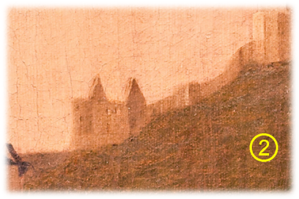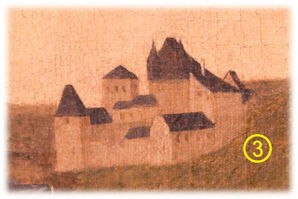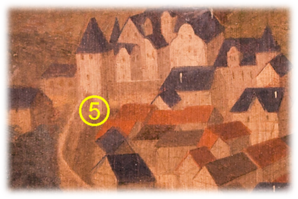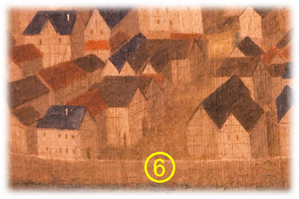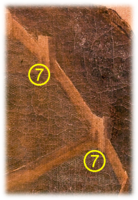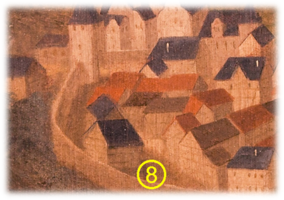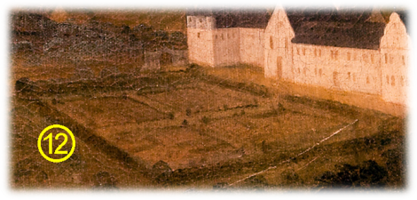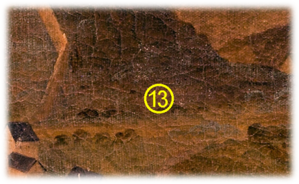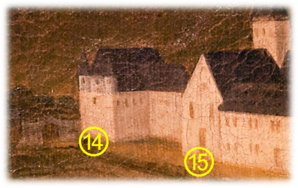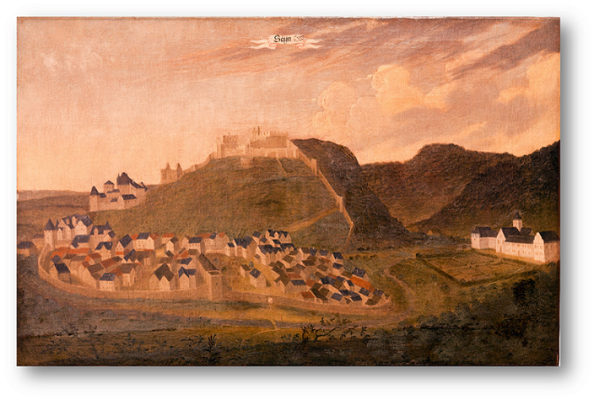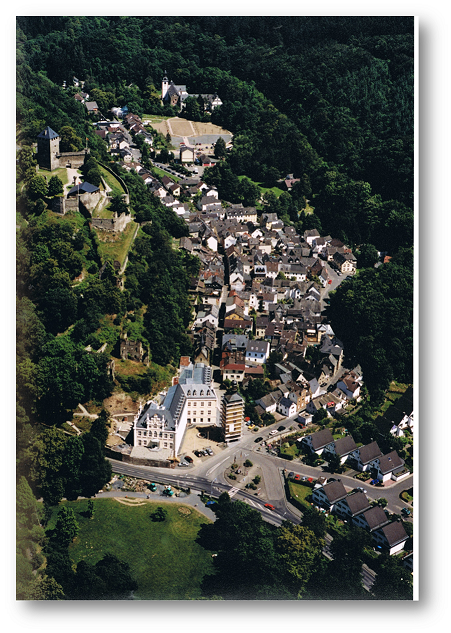Sayn around 1720
Text with pictures download
The oldest depiction showing the town of Sayn as a whole can be found in the palace of the princes of Sayn-Wittgenstein-Berleburg in Bad Berleburg. The picture is one of eight oil paintings of palaces and castles from the former counties of Sayn and Wittgenstein. a
When the picture was painted 90 years had passed since the destruction of the castle by the Swedes (1633). The outdoor walls still remain however. For the viewer of the picture to the right (east) the castle bailey and the residential quarters adjacent to the ring wall can be seen. To the West there are still the living quarters with the chapel.
In 1830 for the sake of a viewing point some of the ruin was cleared away including
the chapel. Its foundations with the threefold nave and a significant decorative floor from the 13th Century were uncovered in 1983/84.
Through marriage it came to be in the possession of the barons (Counts from 1790)
of Boos-Waldeck, who turned it into a Barock county house.
In turn this was passed on to the possession of Prince Ludwig Sayn-Wittgenstein
and by way of many renovations and extensions became the palace we know today as the princely palace. In those days Sayn was entered by a tower ⑤, the gate to which led onto the street today known as Abbey Street.
The current palace tower is located here.
In front of the wall in Abbey Street the Wentz’sche castle house was located. Today the premises can be accessed from 51, Brex Street. In the cellar of the building there are still parts of the old wall and in 2013 further remains of the wall were found on a level with this house down to the brook. These seemingly mark the corner at which the walls met. If you follow on you reach two gate towers. ⑦.
Leading to the one below a path can clearly be seen. The wall seems to have been destroyed or covered up by plants in the lower part. Today nearly all the remains are hidden under ivy. Between Abbey Street and the Brex brook they have completely disappeared. The fortification went down to the brook and then along the brook in the direction of the palace. The wall which is now there is much narrower and was probably put up in the 19. Century. The street that goes down there was called brook street at that time. Its course can be seen only in the front part near the palace because there are two parallel rows of houses ⑧ the triangular gables of which face the street. In the direction of the abbey there is an extensive street section which has only been built up on one side.
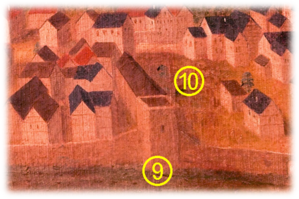
At the point where the wall is interrupted by a tower ⑨ the broadest alley in Sayn is located. Since 1936 it has been called „Castle alley“, before it was named„Market Street“, and colloquially often „Off der Lenn“ (Lime) ⑩ . It leads - as do all alleys in Sayn - to Abbey Street. The building at the end of Market Street was the parish hall (today a grocer’s called Becker). The small low building is the Sebastian Chapel, built in the 1660s by the community as a result of a vow at the end of the plague. Even today mass is regularly held there. Next to the chapel there was in the 19th and early 20th Century the fairground tree. In the „Lenn“ street the fairground stalls were located.
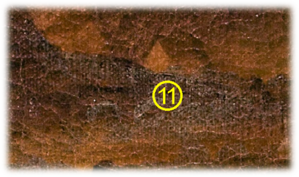
The brook comes from the Brex valley and runs the abbey mill which is located at the end of the valley ⑪, before it passes under an arch bridge and flows past the abbey.
Between the abbey buildings and the abbey garden ⑫ it is covered by a hedge and in the front to the right by the hill and only re-enters the picture on a level with the start of the wall. The abbey garden gave the kindergarten its name: „Kindergarten of the Prelate’s garden“ (1999). It is as broad as all the cloister buildings and forms a square. Later it was enlarged by all the unbuilt land surrounding.
The artificially installed abbey Street had the same path in 1720 as it does now 13. The Barock garden is encased on all sides by a tall hedge. It has been divided up by relatively broad paths into four fields. Along the ways running vertical to the convent buildings there a conifers. In general yews are used sometimes fir trees. The garden probably has both plants for consumption or use and for decoration. The striped structures within the fields seem to suggest this. Generally in such abbey gardens there were no trellis fruit trees, only vegetable patches and beds for flowers used for decorating the church. d
The Sayn abbey was always outside the wall. It could be reached via the named arch bridge and quarrystone and first reached the „Porta nova“, a reception building ⑭ for guests and pilgrims. This was next to the part of the cemetery which is no longer used today and was removed after the cessation of the Abbey (1803). The Abbey church can be seen from the West façade and the main entrance 15 and the windows.
Over the part where nave and transept of the church intersect, there is the Romanesque intersection ⑯. It was broken off in 1730 and replaced by today’s church tower with a Barock hood. In the right hand corner of the church there is the convent building which today has hardly changed. ⑰ It is still called the „big school“, as from 1824-1980 the school was located there. The building adjacent at a right angle is the abbot’s building the „Prelature“ ⑱, today’s Parish house. It can be recognized by the gable, a trade mark of Barock art. Above the North façade that is not quite facing the observer is written : „E. C. A. P. 1718“. This means that the Abbot Engelbert Colendal in 1718 had this building put up. The date of the oldest complete depiction of the town of Sayn is proved. It must have come up between 1718 and 1730. e
The aerial view from 2001 f shows, that the old heart of Sayn has kept ist shape throughout the centuries because the topgraphy of the Brex valley holds it to tight boundaries. Sayn, since 1928 a part of Bendorf, nowadays has about 4700 inhabitants, of which only about a fifth live in Old Sayn.
Dietrich Schabow
„Sayn“ oil painting by an unknown painter around 1720
(picture: Ron Allen, photography, Bad Berleburg)
Aerial view (Herbert Scholz 2001)
At the forefront the palace park. At the palace the abbey street begins (centre oft he picture) and Brex Street (right). / Left oft he castle hill: on a level with the palace the Stein’sche Castle house above that the counts castle. / Abbey Sayn in the background, in front the former abbey garden, which at the time was being changed into a car park and a meadow with trees . / The Brex brook runs out of the valley and alond the edge of the town to the palace tower from where it goes under the the tower and reappears above groud in the park.




